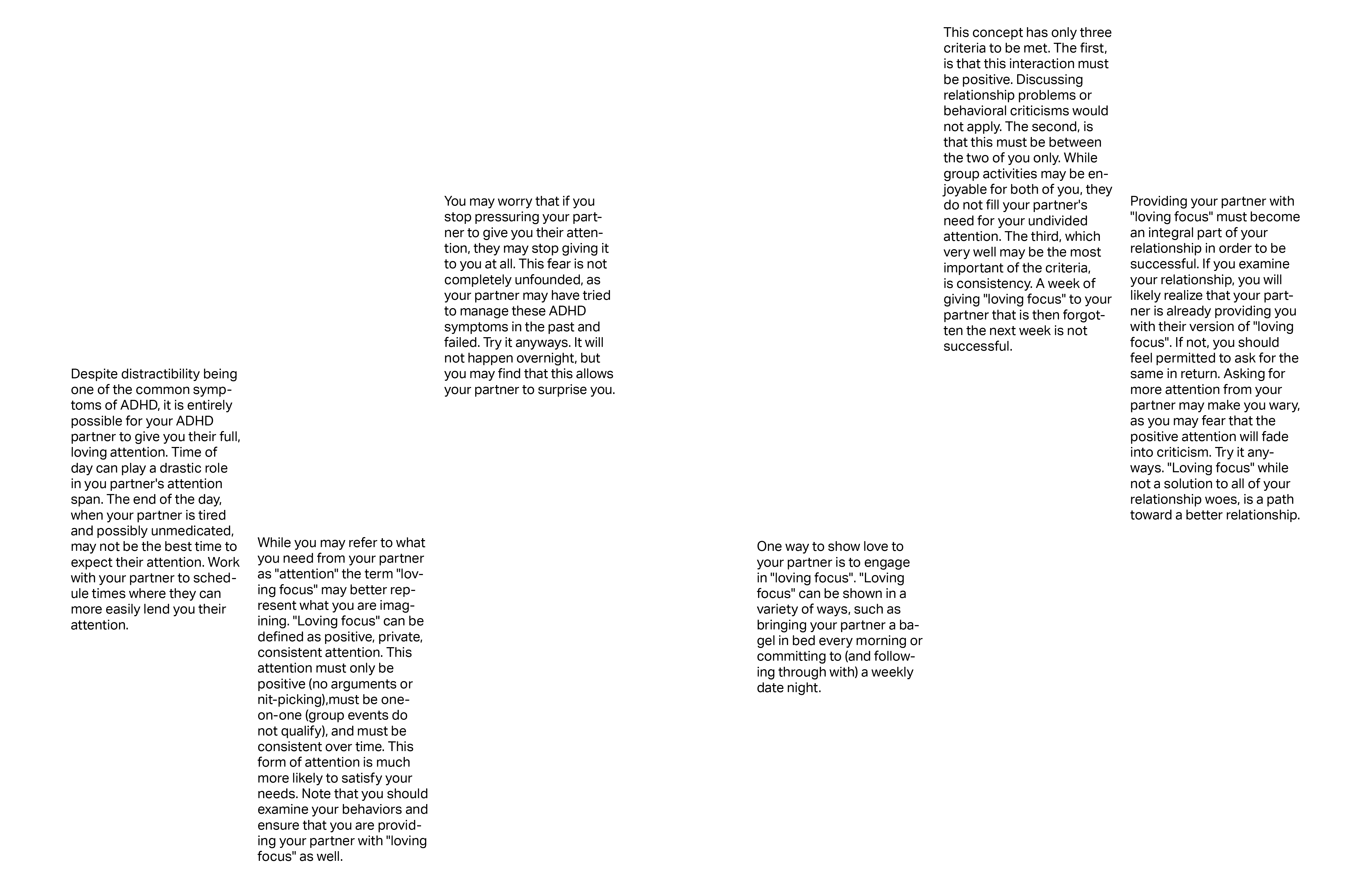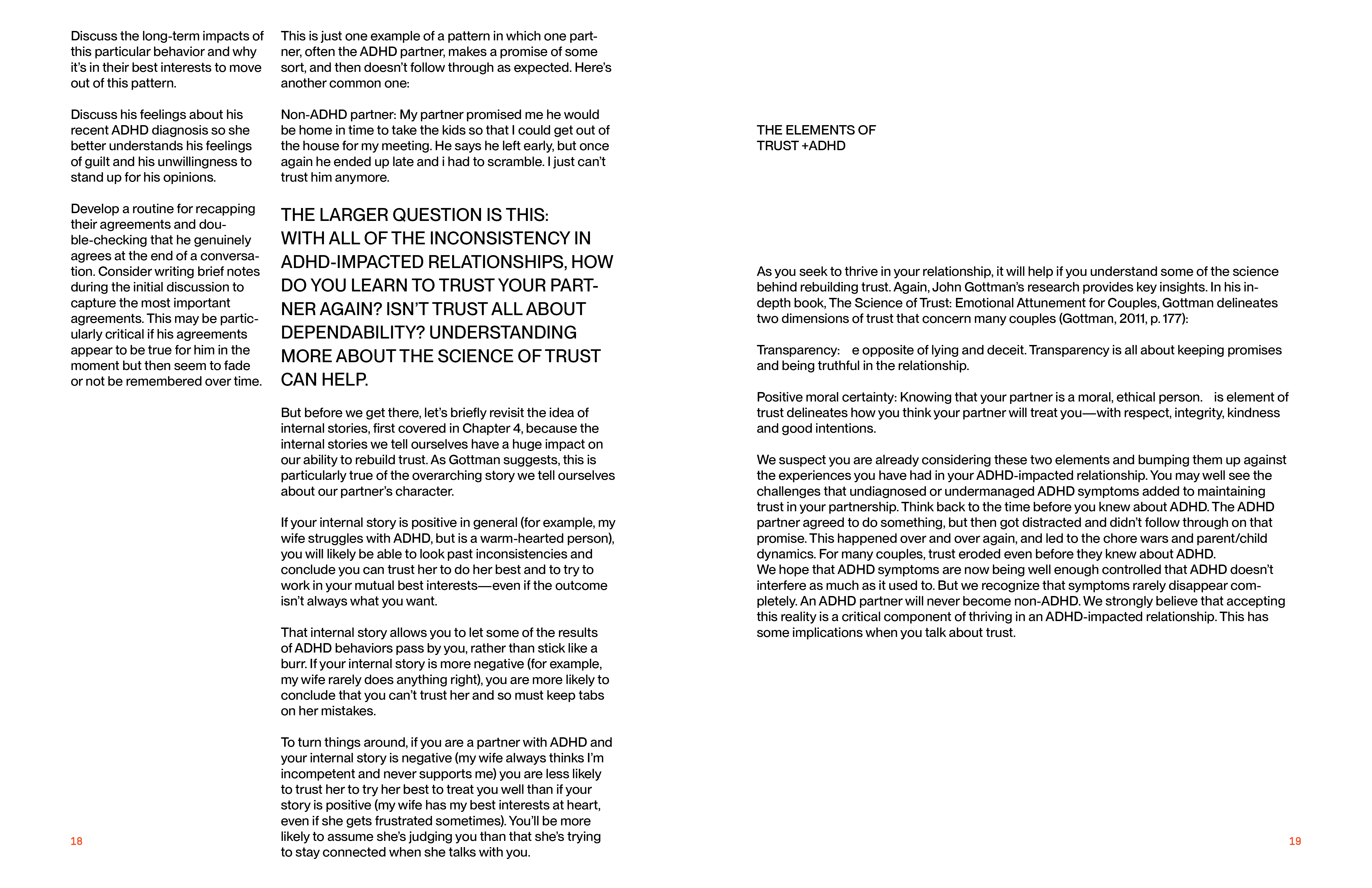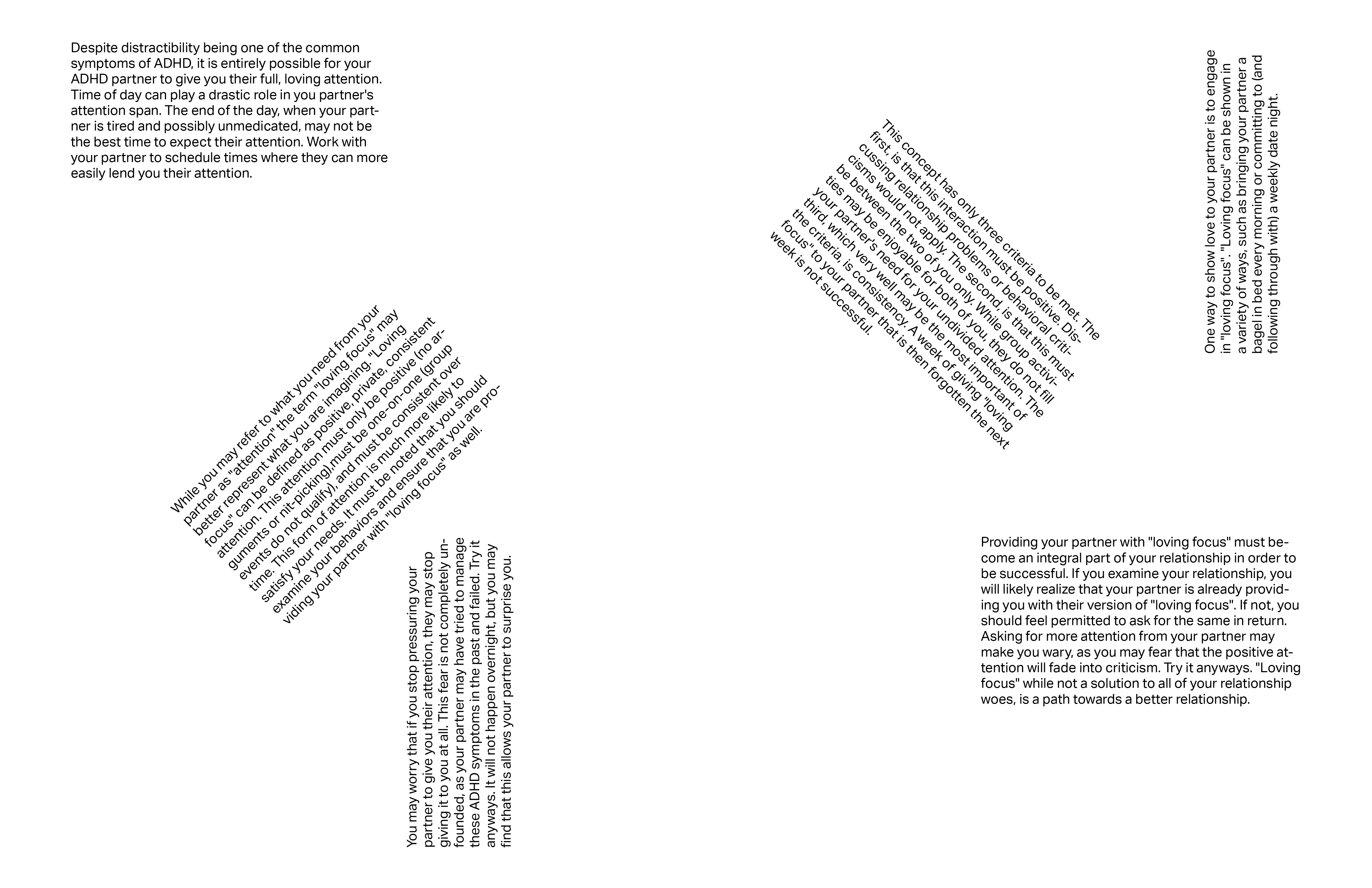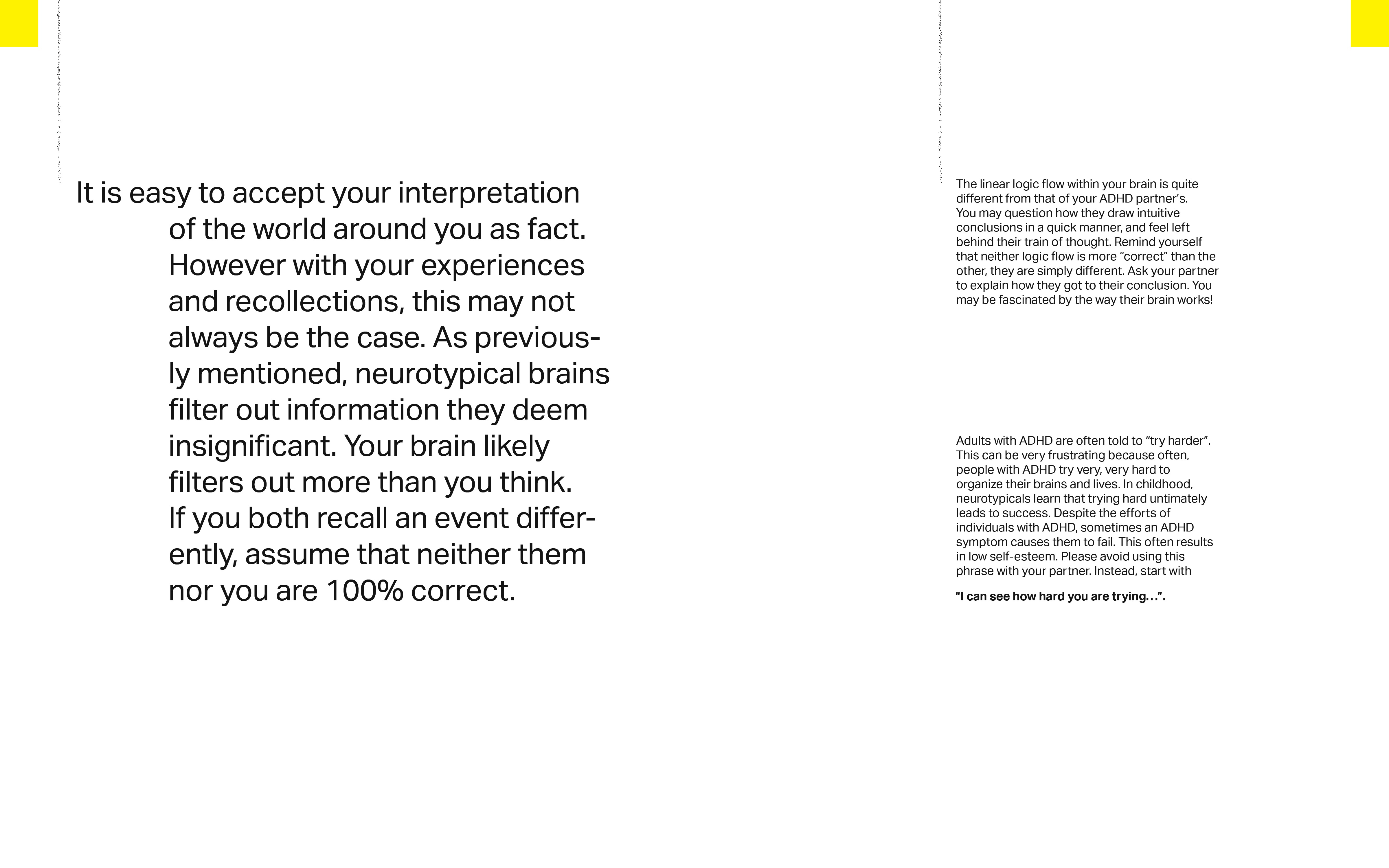FOCUS HERE
The Challenge
Almost 50% of marriages in the United States end in divorce. Factoring an ADHD diagnosis into the equation, the likelihood of divorce doubles.
The Solution
Focus Here is a guide to the complex dynamics of adult, ADHD-impacted relationships. Designed to retain the attention of those with wandering minds, spreads address the ADHD partner, the neurotypical partner, or both partners. The book provides readers with insight into their partner’s perspective while simultaneously teaching them techniques to navigate the complexities that ADHD brings to a relationship.

Research Methodology
This project followed a four stage research process.
This project followed a four stage research process.
Stage 1: Discover
User Survey
Stakeholder Interviews
Expert Interview
Reading Comprehension Studies
User Survey
Stakeholder Interviews
Expert Interview
Reading Comprehension Studies
Stage 2: Explore
Design Criteria
Personas
Customer Journey Map
Prototyping
Design Criteria
Personas
Customer Journey Map
Prototyping
Stage 3: Test
User Testing
Prototyping
User Testing
Prototyping
Stage 4: Listen
Final Product
Takeaways
Final Product
Takeaways
Project Goals
Goal 1:
Build empathy between ADHD adults and their neurotypical partners.
Build empathy between ADHD adults and their neurotypical partners.
Goal 2:
Keep ADHD readers engaged with the content.
Keep ADHD readers engaged with the content.
STAGE 1
DiscoverUser Survey
A survey of 18 neurotypical partners of ADHD individuals was conducted, asking the user to identify traits or behaviors they see in their ADHD partner frequently. A list of 31 behaviors associated with ADHD were provided to the user.
Survey Objectives
A survey of 18 neurotypical partners of ADHD individuals was conducted, asking the user to identify traits or behaviors they see in their ADHD partner frequently. A list of 31 behaviors associated with ADHD were provided to the user.
Survey Objectives
-
How do neurotypical partners of ADHD adults define ADHD?
-
How do neurotypical partners of ADHD adults see ADHD manifest in their partners?
- How do neurotypical partners of ADHD adults see their partner’s ADHD affecting their relationships?


User Interviews
To gain more insight into the audience, 3 couples were interviewed. Individuals were interviewed separately.
Expert Interview
To gain more insight into the audience, Dr. Karacostas M.D., Ph.D. was interviewed about adults with ADHD. Insights were drawn from both expert and user interviews.
Interview Objectives
To gain more insight into the audience, 3 couples were interviewed. Individuals were interviewed separately.
Expert Interview
To gain more insight into the audience, Dr. Karacostas M.D., Ph.D. was interviewed about adults with ADHD. Insights were drawn from both expert and user interviews.
Interview Objectives
-
Have the ADHD read literature about ADHD and relationships before?
- Where is the lack of understanding between ADHD and neurotypical partners?



Reading Comprehension Study 1
Audience members with ADHD were given a passage and asked to mark the spot where their attention began to stray.
Reading Comprehension Study 2
Next, users were shown different amounts of text per page and asked if it overwhelmed them/deterred them from reading the provided content.
Audience members with ADHD were given a passage and asked to mark the spot where their attention began to stray.
Reading Comprehension Study 2
Next, users were shown different amounts of text per page and asked if it overwhelmed them/deterred them from reading the provided content.



STAGE 2
ExploreDesign Criteria
Based on insights from stage 2, three design criteria were decided upon.
Based on insights from stage 2, three design criteria were decided upon.
Criteria 1
This project must build empathy between ADHD adults and their neurotypical partners.
This project must build empathy between ADHD adults and their neurotypical partners.
Criteria 2
This project must be formatted in a way that captures and retains the attention of ADHD individuals.
This project must be formatted in a way that captures and retains the attention of ADHD individuals.
Criteria 3
This project must demonstrate the skills and design acquired during the 5-year design program.
This project must demonstrate the skills and design acquired during the 5-year design program.
Personas
Personas are designed to reflect couples interviewed as well as the results of the initial survey.
Personas are designed to reflect couples interviewed as well as the results of the initial survey.


User Journey Map
Follow a day in the life of a target user.
Follow a day in the life of a target user.

Prototyping
Initial layout explorations.
Initial layout explorations.






















STAGE 3
TestA/B Testing
ADHD users are given five layouts with different methods of differentiating paragraphs, and then asked which they would be most interested in reading.
ADHD users are given five layouts with different methods of differentiating paragraphs, and then asked which they would be most interested in reading.


Layout Iterations
Layout iterations that reflect the results of A/B testing.
Layout iterations that reflect the results of A/B testing.










Layout Iterations
Further layout iterations.
Further layout iterations.




















STAGE 4
ListenFinal Design










Introduction
Book introduction spreads.
Book introduction spreads.










Chapter 1
Full Chapter 1 spreads.
Full Chapter 1 spreads.
























Chapter 2
Full Chapter 2 spreads.
Full Chapter 2 spreads.
































































Chapter 3
Full Chapter 3 spreads.
Full Chapter 3 spreads.
























































Chapter 4
Full Chapter 4 spreads.
Full Chapter 4 spreads.












































Reflection
Upon completing this project and receiving feedback from users, I reflect on my process and what I would do differently.
Upon completing this project and receiving feedback from users, I reflect on my process and what I would do differently.
Given the time constraints of this project, I would focus more of my time on Phase 3 (user testing) and less time on Phase 2 (personas and the customer journey map). I would also implement A/B testing more frequently while designing iterations.